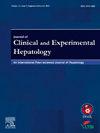Early Prediction of Acute Kidney Injury Following Liver Transplantation: Development and Validation of a Clinical Risk Model
IF 3.2
Q2 GASTROENTEROLOGY & HEPATOLOGY
Journal of Clinical and Experimental Hepatology
Pub Date : 2025-08-29
DOI:10.1016/j.jceh.2025.103179
引用次数: 0
Abstract
Background
The first 48 h following liver transplantation (LT) represent a critical therapeutic window. Early identification of patients who are at high risk of developing acute kidney injury (AKI) can optimize treatment strategies and improve patient outcomes. This study aimed to develop and validate a clinical risk prediction model for AKI within 48 h following LT by utilizing preoperative and intraoperative parameters.
Methods
A total of 453 adult LT recipients treated at the Beijing Tsinghua Changgung Hospital between January 2018 and October 2022 were enrolled. Patients were randomly assigned to a development cohort and a validation cohort at a 6:4 ratio. AKI was diagnosed using the 2012 Kidney Disease Improving Global Outcomes (KDIGO) criteria. Univariate and multivariate logistic regression analyses identified clinical factors associated with early AKI. A predictive model was constructed and internally validated. Additionally, stages 2 and 3 AKI, as defined by the KDIGO criteria, were classified as severe AKI. Independent risk factors for severe AKI within 48 h following LT were similarly identified using logistic regression analyses.
Results
At 48 h following LT, 125 (46%) patients developed AKI. Univariate analysis identified 17 potential predictive factors for AKI, including preoperative hepatic encephalopathy (HE), a history of alcohol-associated cirrhosis, body mass index ≥28 kg/m2, and a prognostic nutritional index > 43 (P < 0.1). A backward stepwise regression model was utilized to develop a clinical risk prediction model incorporating the following variables: HE, alcohol-associated cirrhosis, preoperative albumin–bilirubin score ≥ −1.78, operation time ≥560 min, and intraoperative fresh frozen plasma transfusion volume (per 1000 mL). The model achieved an area under the curve (AUC) of 0.760 (P < 0.05) in the development cohort and 0.759 (P < 0.05) in the validation cohort. The calibration curve indicated excellent agreement between predicted and observed probabilities of early AKI (P > 0.05). Multivariate logistic regression analysis identified the preoperative model of end-stage liver disease score ≥14, operation time ≥560 min, intraoperative blood loss ≥1000 mL, intraoperative urine output <1000 mL, and elevated lactic acid level as independent risk factors for severe AKI.
Conclusion
The proposed predictive model could promote the identification of high-risk LT recipients immediately following surgery, enabling clinicians to intervene early to mitigate the risk of developing AKI within 48 h postoperatively. This approach has the potential to improve patient prognosis by supporting timely and targeted management strategies.

肝移植后急性肾损伤的早期预测:临床风险模型的建立和验证
肝移植后的前48小时是一个关键的治疗窗口期。早期识别发生急性肾损伤(AKI)的高风险患者可以优化治疗策略并改善患者预后。本研究旨在利用术前和术中参数,建立并验证肝移植后48小时内AKI的临床风险预测模型。方法纳入2018年1月至2022年10月在北京清华长庚医院接受治疗的成人肝移植受体453例。患者以6:4的比例随机分配到发展队列和验证队列。AKI的诊断采用2012肾脏疾病改善全球预后(KDIGO)标准。单因素和多因素logistic回归分析确定了与早期AKI相关的临床因素。建立了预测模型并进行了内部验证。此外,根据KDIGO标准定义的2期和3期AKI被归类为严重AKI。在LT后48小时内发生严重AKI的独立危险因素同样通过逻辑回归分析确定。结果肝移植后48小时,125例(46%)患者发生AKI。单因素分析确定了AKI的17个潜在预测因素,包括术前肝性脑病(HE)、酒精相关性肝硬化史、体重指数≥28 kg/m2和预后营养指数43 (P < 0.1)。采用后向逐步回归模型建立临床风险预测模型,纳入HE、酒精相关性肝硬化、术前白蛋白-胆红素评分≥- 1.78、手术时间≥560 min、术中新鲜冷冻血浆输血量(每1000 mL)等变量。该模型在开发组和验证组的曲线下面积(AUC)分别为0.760和0.759 (P < 0.05)。校正曲线显示早期AKI的预测概率与观测概率非常吻合(P > 0.05)。多因素logistic回归分析发现,术前模型终末期肝病评分≥14分、手术时间≥560 min、术中出血量≥1000 mL、术中尿量≥1000 mL、乳酸水平升高是严重AKI的独立危险因素。结论所建立的预测模型可以促进术后高风险LT受体的识别,使临床医生能够在术后48小时内进行早期干预,以降低发生AKI的风险。这种方法有可能通过支持及时和有针对性的管理策略来改善患者预后。
本文章由计算机程序翻译,如有差异,请以英文原文为准。
求助全文
约1分钟内获得全文
求助全文
来源期刊

Journal of Clinical and Experimental Hepatology
GASTROENTEROLOGY & HEPATOLOGY-
CiteScore
4.90
自引率
16.70%
发文量
537
审稿时长
64 days
 求助内容:
求助内容: 应助结果提醒方式:
应助结果提醒方式:


